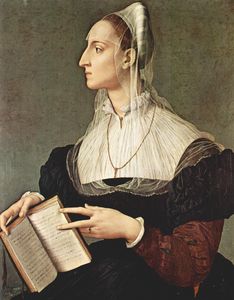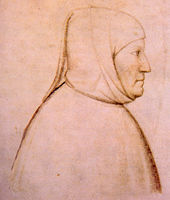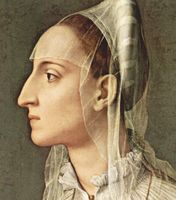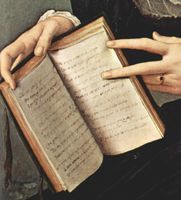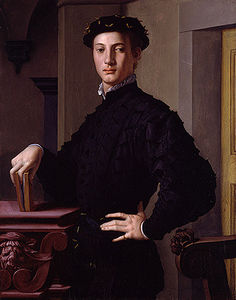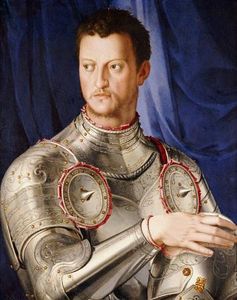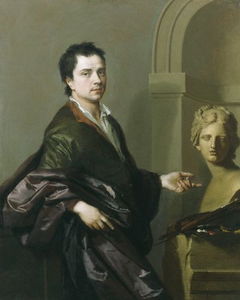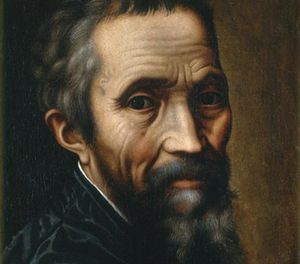Portrait of Laura Battiferri
- Date of Creation:
- circa 1560
- Height (cm):
- 83.00
- Length (cm):
- 60.00
- Medium:
- Oil
- Support:
- Canvas
- Subject:
- Figure
- Art Movement:
- Mannerism
- Created by:
- Current Location:
- Florence, Italy
- Portrait of Laura Battiferri Page's Content
- Story / Theme
- Analysis
- Related Paintings
- Artist
- Art Period
- Bibliography
Portrait of Laura Battiferri Story / Theme
The sitter in this portrait is 16th-century Italian poet Laura Battiferri. Although Bronzino was primarily a painter, he also fancied himself a poet and often painted portraits of his literary friends and colleagues. Laura Battiferri lived in Florence and married the Florentine sculptor Bartolommeo Ammanati at the age of 27.
The couple was part of the high society of Florence thanks to their well acclaimed artistic and literary endeavors. They were childless, but not for lack of trying. Battiferri sometimes referred to herself as a "barren tree. " Her poetry spread through the literary communities of Italy and made it as far as the Spanish court where her work was translated into Spanish. Writers of the time flocked to her for her smart company.
This portrait is considered by some to be the most fascinating female portrait of this time period. Battiferri's slender fingers mark a page in an open book of Petrarch's sonnets to Laura, with whom the sitter identifies. According to Petrarch, Laura is an "unapproachable, unattainable beauty... as chaste as the adored mistress of a troubadour, as modest and devout as a 'Stilnovismo Beatrice'". "Laura's personality is even more elusive than her external appearance. She remains the incarnation of chaste and noble beauty."
Portrait of Laura Battiferri Analysis
This portrait is renowned for its break from convention, not only conventions Bronzino helped to establish, but other portraiture and gender norms of the time.
Profile:
Battiferri is shown from the side, offering a clear look at her profile and long, almost hooked nose. Bronzino unnaturally draws out her forehead slightly to call attention to the size and shape of her nose. Women, or men for that matter, were rarely, if ever, painted from the side during this time. Her head also appears slightly smaller than normal proportion would allow and her neck has been elongated, which is a trademark of the Mannerist style. Battiferri's head and position is also reminiscent of a coin profile.
Realistic presentation:
Bronzino does, like in most of his portraits, take great care to mold Battiferri's face in three-dimensional-appearing contours. This was his trademark: ultra realistic style. Laura has a very focused look on her face and her blank expression is also exemplary of many of Bronzino's portraits.
Pose:
Laura Battiferri, a supporter of the Jesuitical Counter-Reformation, was reputed to have been a devout Catholic. Her great popularity at the Spanish court confirms this. The demure severity of her pose and dress may reflect the increased rigidity of Catholic ethical norms since the Council of Trent (1545-1563).
Color:
Bronzino uses mundane colors, primarily white, gray, black and beige. In many of Bronzino's other portraits, he uses more dramatic tones like reds and blues.
Portrait of Laura Battiferri Related Paintings
Portrait of Laura Battiferri Artist
Many believe Bronzino's portraits of literary figures to be his most personal works and his portrait of Laura Battiferri proved particularly fascinating. Typically, Bronzino's portraiture style meshed a detached realism depicting cold and often arrogant expressions of his sitters with bold colors such as ice blue and raspberry red.
Bronzino's painting technique is extremely controlled and meticulous. His brushstrokes appear non-existent, which gives his work the extremely realistic, almost life-like appearance, especially in his portraits. Bronzino's attention to detail was of the highest standard.
Bronzino had broad influence over court portraiture for an entire century following his death in 1572. The aloof, detached style he used to capture the noble class of Florence, in its decadent and arrogant pride spread throughout Europe reaching courts as far as Elizabethan England.
Bronzino's portraits are his primary genius and legacy to the art world and several artists were particularly inspired by his unique style, including Alessandro Allori, Michael Dahl and Jean Auguste Dominique Ingres.
Portrait of Laura Battiferri Art Period
The Mannerist movement developed around 1520 in either Florence or Rome and replaced the High Renaissance era. It lasted until around 1580 with the emergence of the Baroque style. Early Mannerist painters include Andrea del Sarto, Jacopo Pontormo and Rosso Fiorento. Such artists are known for their elongated forms and theatrical lighting.
Mannerism combines various styles and is heavily influenced by the restrained naturalism related to painters such Raphael, Michelangelo and Leonardo da Vinci.
The mannerist portrait of Angelo Bronzino was born in Florence - a city believed by many Florentine exiles to be built on corruption after the fall of the last republic in 1530 and the development of dynastic rule by the Medici. Yet, this did not stop the young Bronzino and his works soon caught the eye of the ruling class and in his later career, Bronzino even became court painter to the Medici family.
Mannerist portraits by Agnolo Bronzino are distinguished by a still sophistication and superb attention to detail. Bronzino focused heavily on the clothing and materials featured in his works and this was often said to create a gulf between the subject and viewer.
Portrait of Laura Battiferri Bibliography
To read more about Bronzino and his artworks please refer to the recommended reading list below.
• Brock, Maurice. Bronzino. Flammarion, 2002
• Cecchi, Alessandro. Bronzino (The library of great masters). Constable, 1997
• Cox-Rearick, Janet. Bronzino's Chapel of Eleonora in the Palazzo Vecchio. University of California Press, 1993
• Falciani, Carlo & Natali, Antonio. Bronzino: Painter and Poet at the Court of the Medici. Mandragora, 2010
• Levey, Michael. Bronzino. Purnell, 1967
• McComb, Arthur Kilgore. Agnolo Bronzino: His Life and Works. Harvard University Press, 1928
• Pilliod, Elizabeth. Pontormo, Bronzino, Allori: A Genealogy of Florentine Art. Yale University Press, 2001
• Strehlke, Carl Brandon. Pontormo, Bronzino, and the Medici: The Transformation of the Renaissance Portrait in Florence. Pennsylvania State University Press, 2004

